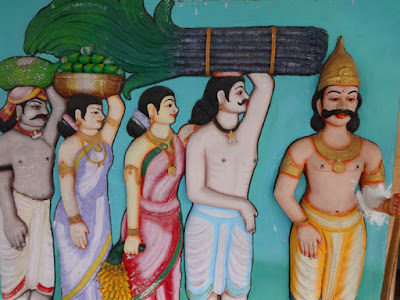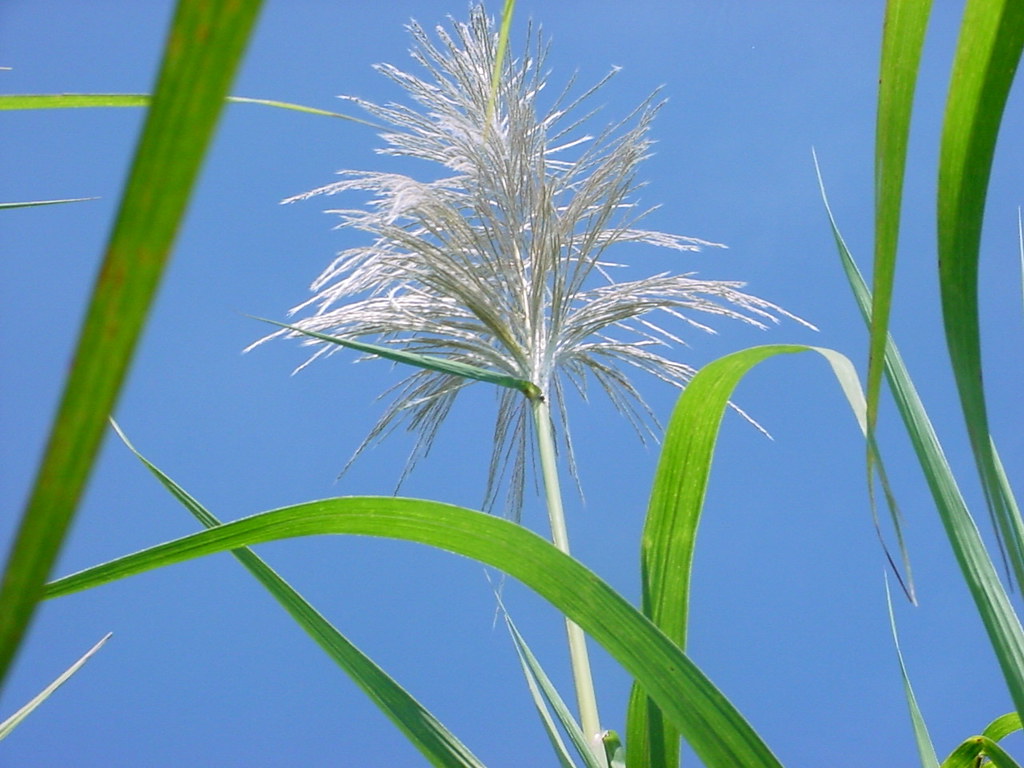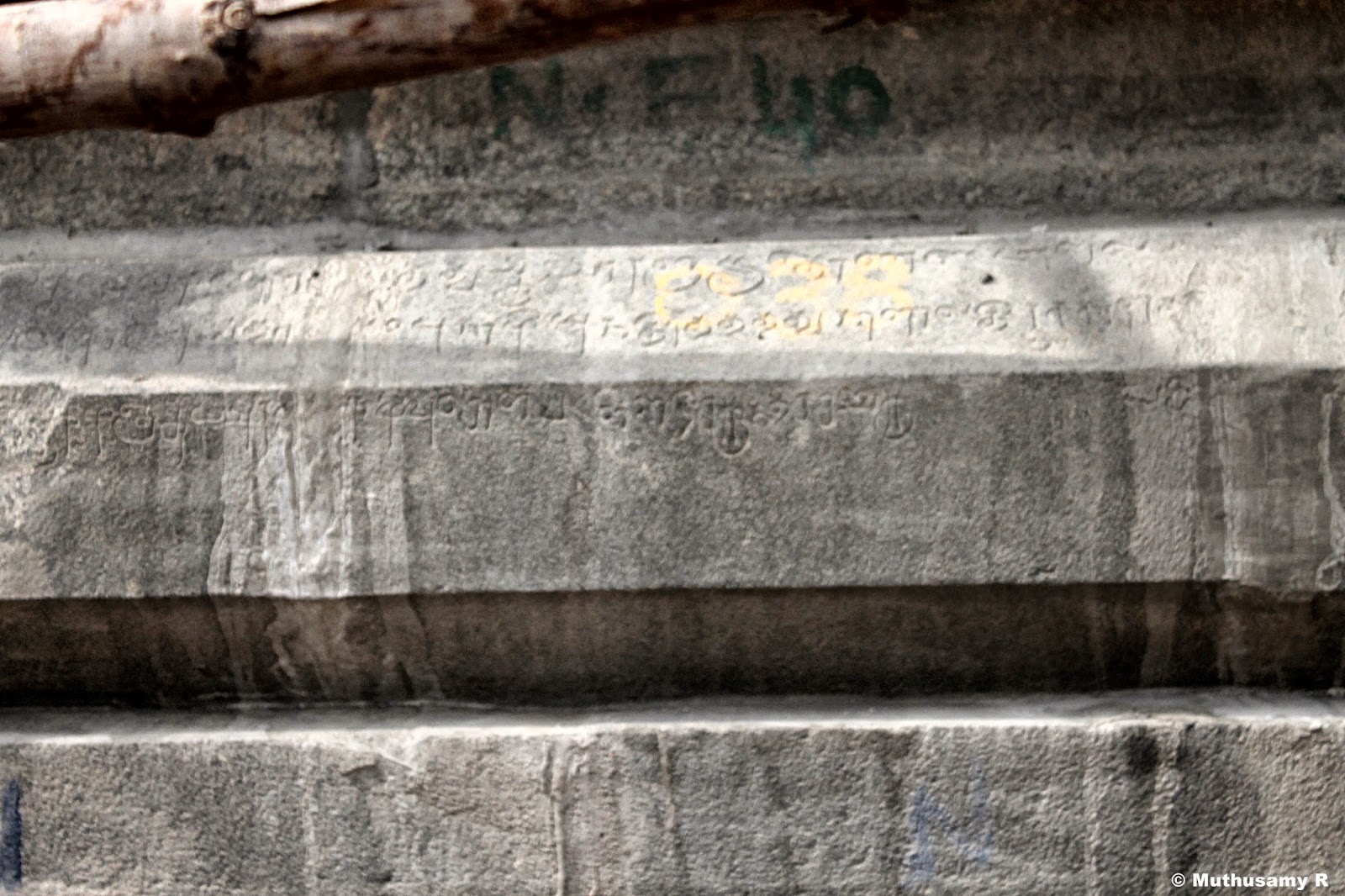
Sugarcane is a tall perennial, thick-stemmed, colourful, soft and juicy, plant growing erect even up to 5 to 6 meters. Botanically the genus Saccharum is in the family Poaceae, sub-family Panicoidae, in the major group Angiosperms (Flowering plants). "In 1753, Linnaeus established this genus Saccharum along with the other crop plants in his master-piece Species Plantarum." There are around 200 species under genus Saccharum. Six species have been identified in the genus Saccharum viz., S. officinarum, S. barberi, S. sinense, S. robustum, S. edule and S. spontaneum. Saccharum officinarum is the type species of sugarcane. Approximately 70% of the sugar produced globally comes from S. officinarum and hybrids using this species. "The word saccharum owes its origin to the Sanskrit word 'sarkara' or 'sakkara' meaning sugar. This became 'sukkar' in Arabic and 'Sakharon' in Greek."
History of Sugarcane is 8000 years old. When people migrating from the Indochina area to New Guinea in the South Pacific during ancient times they discovered wild sugar cane. New Guinean farmers domesticated different species of sugarcane i.e., Saccharum edule and Saccharum officinarum. The crop was probably first cultivated in the island of New Guinea. Originally, people chewed sugarcane raw to extract its sweetness. From about 8000 B.C. on, people migrated from New Guinea to the nearby Solomon Islands, the New Hebrides and then to New Caledonia taking a cultivated form of sugarcane with them. About 2000 years later sugarcane reached Indonesia, the Philippines, and then Northern India. From Northern India sugarcane species (Saccharum barberi) spread to China around 800 B.C. Sugarcane has a very long history of cultivation in the Indian sub-continent. The earliest reference to it from Atharva Veda (1500 - 800 B.C.). The text is shown below:
“This plant is born of honey, with honey do we dig for thee. Of honey thou art begotten, do thou make us full of honey!
At the tip of my tongue may I have honey, at my tongue’s root the sweetness of honey! In my power alone shalt thou then be, thou shalt come up to my wish!
Sweet as honey is my entrance, sweet as honey my departure. With my voice do I speak sweet as honey, may I become like honey!
I am sweeter than honey, fuller of sweetness than licorice. Mayest thou, without fail, long for me alone, (as a bee) for a branch full of honey!”
I have surrounded thee with a clinging sugarcane, to remove aversion, so that thou shalt not be averse to me!”
The word "Chakara" was frequently referred in many Sanskrit texts. Ayurvedic authors Charaka and Susruta mentioned the sugarcane in many places. Susruta samhita listed 12 varieties. The best of which were called Vamshika (with thin reeds) and Paundraka (which came from the Bengal region).
The sugarcane bow and the five flower arrows are described as the weapon of the god Kamadeva.
Sugarcane was originally grown for the sole purpose of chewing. Extraction of sugarcane juice and preparation of sugar by boiling the juice commenced from India. during first million B.C. According to Jain legend their first Thirthankara Rishabadeva (Adi Nath) was the one who taught the people of extraction of sugarcane juice. Machines (jiantra) for crushing sugarcanes are mentioned in a description of the winter season in the Upamitibhava prapancha katha, a Jain literature in Sanskrit..
The sugarcane plant and the cane-sugar are frequently mentioned in the Institutes of Manu. The earliest known production of crystalline sugar began in northern India around 400 B.C. Indus Valley civilization shows evidence on their knowledge about sugarcane and sugar extraction. Indus Valley people used crystallized sugar. .The sugar technology was commercially perfected around 700 A.D.
Sugarcane was also found in Persia in 510 B.C. and the Persian military expedition records have information about sugarcane. Nearchos, the admiral of Alexander the Great also confirms the same.
Vedic Aryans in India cultivated barley, rice and sugarcane.“This plant is born of honey, with honey do we dig for thee. Of honey thou art begotten, do thou make us full of honey!
At the tip of my tongue may I have honey, at my tongue’s root the sweetness of honey! In my power alone shalt thou then be, thou shalt come up to my wish!
Sweet as honey is my entrance, sweet as honey my departure. With my voice do I speak sweet as honey, may I become like honey!
I am sweeter than honey, fuller of sweetness than licorice. Mayest thou, without fail, long for me alone, (as a bee) for a branch full of honey!”
I have surrounded thee with a clinging sugarcane, to remove aversion, so that thou shalt not be averse to me!”
The sugarcane bow and the five flower arrows are described as the weapon of the god Kamadeva.
Sugarcane was originally grown for the sole purpose of chewing. Extraction of sugarcane juice and preparation of sugar by boiling the juice commenced from India. during first million B.C. According to Jain legend their first Thirthankara Rishabadeva (Adi Nath) was the one who taught the people of extraction of sugarcane juice. Machines (jiantra) for crushing sugarcanes are mentioned in a description of the winter season in the Upamitibhava prapancha katha, a Jain literature in Sanskrit..
Tamil Sangam Literature
Sangam literature abounds in reference to the sugarcane. Agriculture was the main occupation of Sangam Tamils and importance of agriculture in Tamilakam was well recognized through Eight anthologies and Ten idylls. There was a steady progress in the reclamation of forests and wastelands during Sangam era. Chola king Karikala is considered as the pioneer in ancient Tamilakam to initiate the task of reclamation. In Pattinappalai poet Kadiyalur Urithirankannanar vividly describe the act of reclamation of king Karkalan.
காடு கொன்று நாடாக்கிக்
குளம் தொட்டு வளம் பெருக்கி
(Pattinappalai 283 - 284 poet Kadiyalur Urithirankannanar)
Karikalan destroyed forests and made them habitable, dug ponds, expanded his capital city of Uranthai,
ஆர் குருகு உறங்கும் நீர் சூழ் வள வயல்
கழனிக் கரும்பின் சாய்ப் புறம் ஊர்ந்து
பழன யாமை பசு வெயில் கொள்ளும்
நெல்லுடை மறுகின் நன்னர் ஊர
Akananuru 306, Mathurai Koolavankian Seethalai Sathanar,
What the heroine’s friend said to the unfaithful hero, refusing him entry: Oh man from the fine town, where a heron eats and sleeps on a mango tree whose tender sprouts gently rubs its body, and a field tortoise rests in the warm sun on the side where sugarcanes are leaning in the prosperous field surrounded by water!
Athiyaman Neduman Anji was one of the most powerful Tamil Velir cheiftain of the Sangam period. Poet Avvaiyar was his court poet. It is established from Avvaiyar's Purananuru poem 99 that Atiyars have introduced sugarcane cultivation in the Tamil country.
 |
| Athiyaman Neduman Anji and Poet Avvaiyar PC: Wikimedia |
அமரர்ப் பேணியும் ஆவுதி அருத்தியும்
அரும் பெறல் மரபின் கரும்பு இவண் தந்தும்
நீர் அக இருக்கை ஆழி சூட்டிய
தொல் நிலை மரபின் நின் முன்னோர் போல
Purananuru 99 Poet Avvaiyar sang to Athiyaman Neduman Anji
Like your ancestors of ancient tradition who served the gods and offered oblations to secure the gift that is hard to obtain, sugarcane for this land,
 |
| Athiyaman neduman Anji Introduced Sugarcane. Museum @ Dharmapuri |
... ... ... ... ... ... ... ... ... ... அந்தரத்து
அரும் பெறல் அமிழ்தம் அன்ன
கரும்பு இவண் தந்தோன் பெரும் பிறங்கடையே.
Purananuru 392 Poet Avvaiyar sang to Athiyaman Neduman Anji's son Poruttu Elini
that great heir (Atiyan) who brought us sugarcane, precious to obtain like divine nectar, from the land beyond.
பெருங்களிற்று அடி வழி நிலைஇய நீரே.
Kurunthokai 262: 7 - 8, Cheraman Palai Padiya Perunkadunko,
Elephant foot prints are compared to like the garden beds (பாத்தி) of sugarcane planting holes
இலங்கு பூங்கரும்பின் ஏர் கழை இருந்த
வெண் குருகு நரல வீசும்
Akananuru 13, Perunthalai Sāthanar,
white herons call from the beautiful sugarcanes with bright flowers
 |
| Thick - stemmed white flowers of tall sugarcane |
நீடு கழைக் கரும்பின் கணைக்கால் வான் பூக்
கோடைப் பூளை யின் வாடையொடு துயல்வர
Akananuru 217:3-5, Kalarkeeran Eyitriyanar,
In the vast fields, thick- stemmed, white flowers of tall sugarcane sway in the northerly winds like the poolai flowers of summer.
இரும் பல் மெல் அணை ஒழிய கரும்பின்
வேல் போல் வெண் முகை விரியத் தீண்டி
Natrinai 366:7-8, Mathurai Eelathu Poothan Thevanar,
The cold northern wind blows, opening the spear-like white buds of sugarcanes,
The Chola wet land received water from Cauvery river and water irrigation was abundant to raise paddy. They have also cultivated sugarcane around the paddy fields. The sugarcane provided a fence to the paddy field. It is also learned that the Chola farmers cultivated double crop.
 |
| Sugarcane flower கரும்பின் வெண்பூ |
இலங்கு கதிர் வெள்ளி தென்புலம் படரினும்
அம் தண் காவிரி வந்து கவர்பு ஊட்டத்
தோடு கொள் வேலின் தோற்றம் போல
ஆடு கண் கரும்பின் வெண்பூ நுடங்கும்
Purananuru 35: 6 - 9 Poet Vellaikudi Nakanār sang to Cholan Kulamutrathu Thunjiya Killivalavan
Your country alone is truly a country where lovely, cool Kāviri flows and feeds the land, and appearing like spears, dancing flowers of sugarcanes with nodes sway!
செய் தொழிலான் வியர்ப்பு அறியாமை
ஈத்தோன் எந்தை இசை தனது ஆக
வயலே நெல்லின் வேலி நீடிய கரும்பின்
பாத்திப் பன்மலர்ப் பூத் ததும்
Purananuru 386: 8 - 11 Poet Kovur Kilar sang to Cholan Kulamutrathu Thunjiya Killivalavan
The Chola king's fields are full of flowers that bloom among the patches of sugarcane that are fences for the paddy fields,
முரசுடைச் செல்வர் புரவிச் சூட்டும்
மூட்டுறு கவரி தூக்கியன்ன
செழுஞ்செய் நெல்லின் சேயரிப் புனிற்றுக் கதிர்
மூதா தின்றல் அஞ்சிக் காவலர்
பாகல் ஆய் கொடிப் பகன்றையொடு பரீஇக்
காஞ்சியின் அகத்துக் கரும்பு அருத்தி யாக்கும்
Akananuru 156: 1 - 6 Poet Avur Moolankilar
Oh man from the town with sweet streams, where thick, fine paddy grows, high like lifted tufts adorning the horses owned by rich kings with drums, and field guards protect the tender paddy grains from old cows by tying them to kānji trees with ropes made from the vines of beautiful bittermelon and pakandrai, and feeding them sugarcane!
In Purananuru poem 42: 13 -14 (அறைநர் கரும்பிற் கொண்ட தேனும்) Arainar or the person responsible for cutting sugarcane and also responsible for extracting sap from the sugarcane stems. Puranauru poem 322: 7 - 10 describes vividly the mechanical equipment to make sugarcane juice. Please note the use of term (எந்திரம்) for sugarcane press. The farmers also discovered how to crystallize sugar,probably carried out through the simple process of crushing cut-pieces of cane by a heavy weight and boiling the juice extracted and stirring until solids formed.These solids being of uneven shapes and sizes were called jaggery
கரும்பின் எந்திரம் சிலைப்பின் அயலது
இருஞ்சுவல் வாளை பிறழும் ஆங்கண்
தண் பணை ஆளும் வேந்தர்க்குக்
கண்படை ஈயா வேலோன் ஊரே.
(Purananuru 322: 7 - 10 Poet Avur Kilar,)
In the wasteland city, whose leader is a spearman who grants no sleep to kings of cool cities where the loud sounds of a sugarcane press in the hard land cause a vālai fish with a thick neck to leap nearby.
கரும்பின் எந்திரம் களிற்று எதிர் பிளிற்றும்
தேர் வண் கோமான் தேனூர் அன்ன இவள்
நல் அணி நயந்து நீ துறத்தலின்
பல்லோர் அறியப் பசந்தன்று நுதலே.
Ainkurunuru 55, Poet Orampokiyar,
What the heroine’s friend said to the hero: You desired my pretty friend who resembles Thenur, where the king donates chariots, and sugarcane presses roar like bull elephants. Since you abandoned her, her forehead has become pale, and many have noticed it.
அணங்குடை யாளி தாக்கலின் பல உடன்
கணம் சால் வேழம் கதழ்வுற்றாங்கு
எந்திரம் சிலைக்கும் துஞ்சாக் கம்பலை
விசயம் அடூஉம் புகை சூழ் ஆலைதொறும்
கரும்பின் தீம்சாறு விரும்பினிர் மிசைமின்
(Perumpanatruppadai 257-262 Poet Kadiyalur Urithirankannanar king Thondaimān Ilanthiraiyan)
Sugarcane Juice in the Sugar Mills: The unending, roaring sounds of equipment in every sugarmill where sugarcane juice is boiled, surrounded by smoke, are like the screams of many
elephants that are attacked by an āliin the bamboo growing mountains where clouds play. There you can drink sweet sugarcane juice as much as you desire.
The fertility of the soil of Cauvery delta was the pet theme of poets of Sangam era. The land of Chola had plenty of water for irrigation and was known as 'Punal Nadu' (the land well irrigated). In the idylls of Pattinappalai, poet Kadiyalur Urithirankannanar speaks about the prosperity of agricultural lands in Kaviripoompattinam, the capital city of Chola land ruled by king Karikala is thus described vividly:
வான் பொய்ப்பினும் தான் பொய்யா
மலைத் தலைய கடல் காவிரி
புனல் பரந்து பொன் கொழிக்கும்
விளைவு அறா வியன் கழனி
கார்க் கரும்பின் கமழ் ஆலைத்
தீத் தெறுவின் கவின்
வாடி நீர்ச் செறுவின் நீள் நெய்தல்
பூச்சாம்பும் ... ... ... ... ... ... ...
(Pattinappalai 1 - 12, Kadiyalur Urithirankannanar king Cholan Karikalan)
Kaviri’s Pride: Kaviri, which starts in the mountains and ends in the ocean, does not fail. Its flowing water spreads and showers abundant prosperity. There are continuous yields from wide fields. Fragrant smells waft from sugar mills and heat from their fires wilt the waterlilies in nearby fields, making them lose their beauty.
பொங்கழி ஆலைப் புகையொடும் பரந்து
மங்குல் வானத்து மலையிற் றோன்றும்
Silappatikaram Nadukan Kathai 150 - 152
The smoke of sugarcane pressing factory spreads around the mountain heap of straw and appear like the dark cloud.
Reference:
- Adhiyaman Neduman Anci Wikipedia
- Agricultural Practices as gleaned from the Tamil Literature of the Sangam Age. Srinivasan TM. Indian Journal of History of Science. 51.2.1 (2016). 167 - 169pp. http://www.insa.nic.in/writereaddata/UpLoadedFiles/IJHS/Vol51_2016_2_1_Art01.pdf
- History of Sugar http://www.sugarhistory.net/who-made-sugar/history-of-sugar/
- Sugarcane Wikipedia
- Sugarcane : Classification http://agropedia.iitk.ac.in/content/sugarcane
- Sugarcane: History and Cultivation of Sugarcane http://www.biologydiscussion.com/economic-botany/sugarcane/sugarcane-history-and-cultivation-of-sugarcane/52864
- Sugar History Willem H. Kampen http://www.lsuagcenter.com/portals/communications/publications/agmag/archive/2002/fall/sugarcane-history
- The Sugarcane Bow. Phil Hine. http://enfolding.org/wikis-4/tantra-wikiwikis-4tantra-wiki/tantra_essays/the-sugarcane-bow/
- The Sugarcane Mystery: Indus valley and the Ikshvaku Dynasty. Tamil and Vedas. https://tamilandvedas.com/2011/11/19/the-sugarcane-mystery-indus-valley-and-the-ikshvaku-dynasty/
- What is Sugarcane? History of Sugar Cane http://www.chewingcane.com/sugarcane_history.html
- பண்டைத் தமிழ் இலக்கியங்களில் கரும்பு. வெ பெருமாள்சாமி http://www.valaitamil.com/old-tamil-literature-is-sugarcane_9464.html















